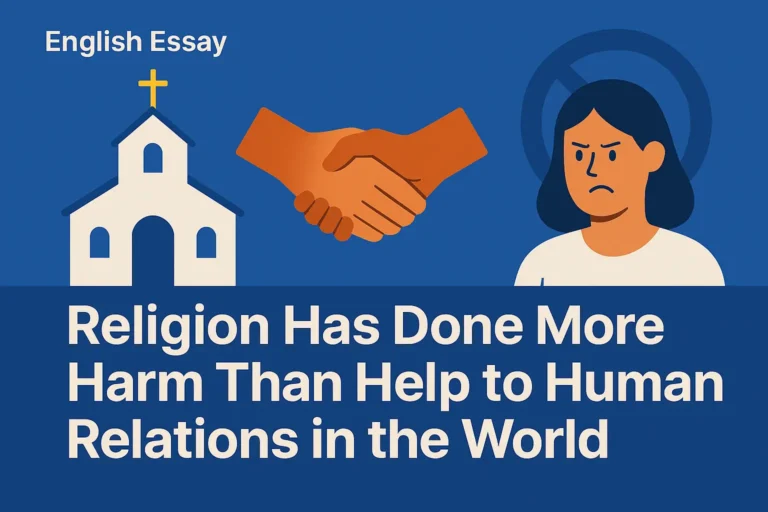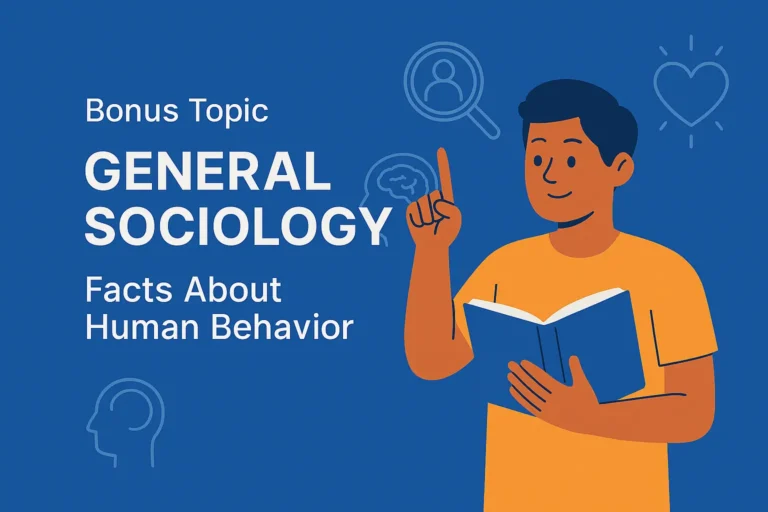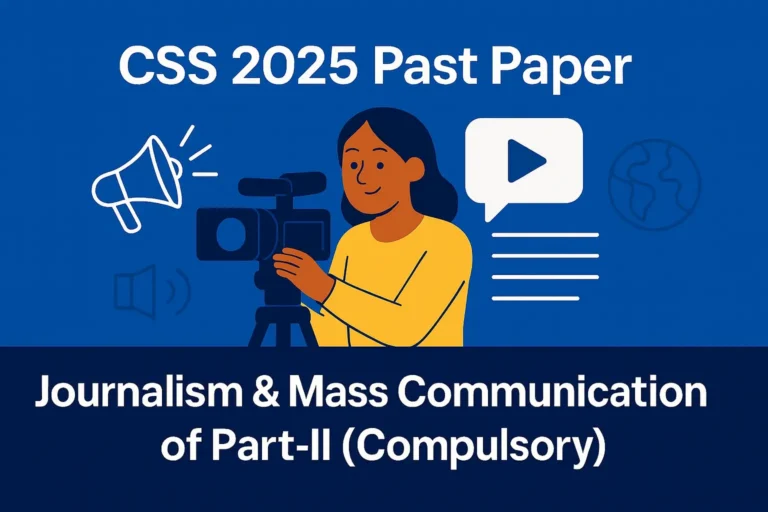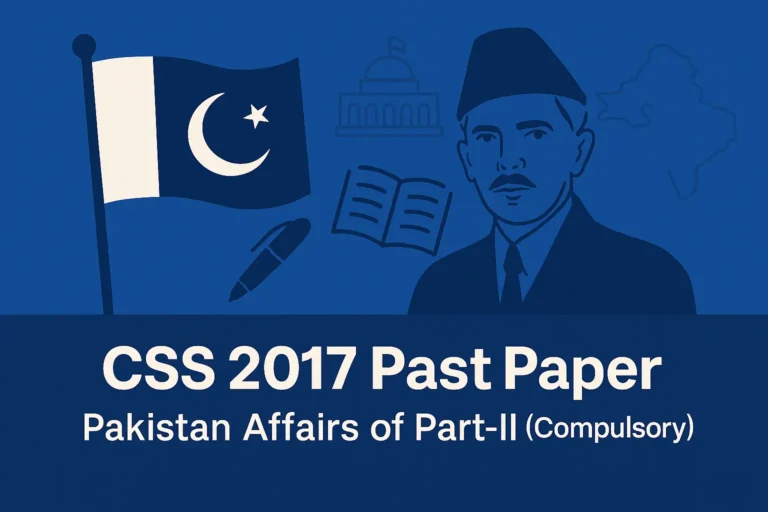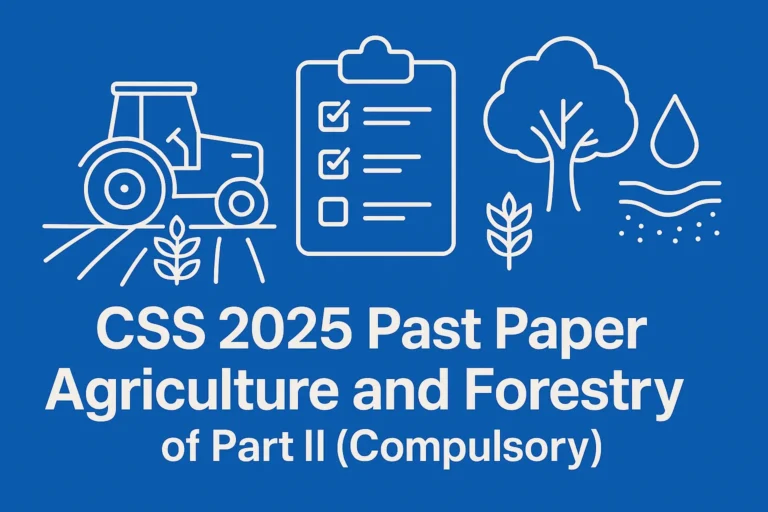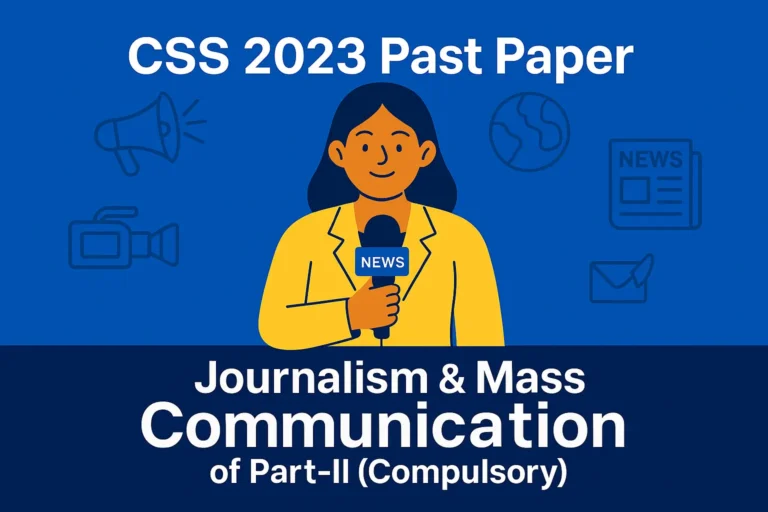CSS 2020 Solved Past Paper – Journalism & Mass Communication Part-II (Compulsory)
Below is the solution to PART-II (COMPULSORY) of the CSS 2020 Journalism & Mass Communication Paper.
Question 2
After defining centrifugal and centripetal effects of mass communication, critically discuss how the Pakistani media helped or hindered the formation of diverse groups and identities based on subculture, opinion, social experience, and social action?
Introduction
Mass communication plays a big role in shaping public opinion and identities in any country. Two important effects in this process are centrifugal and centripetal effects. Both influence how society unites or divides through media. In Pakistan, media has played both positive and negative roles in shaping different groups based on culture, beliefs, and actions.
Definition of Centripetal and Centrifugal Effects
- Centripetal Effect:
This effect brings people together. It promotes unity, shared values, and national identity. Media plays centripetal role when it supports common culture, religion, language, or national causes. - Centrifugal Effect:
This effect divides people. It encourages fragmentation of society into small groups with different identities. When media highlights differences like ethnicity, sect, or political views too much, it causes divisions.
Media’s Role in Pakistan
1. Subculture Formation
Pakistani media has promoted both modern and traditional subcultures.
- Support:
Media shows dramas, songs, and programs that celebrate regional dresses, languages, and traditions. It helps people connect with their roots. Example: Sindhi or Pashto cultural shows on regional channels. - Hindrance:
Sometimes media over-glorifies Western culture, showing it as superior. Youth tries to copy it, and they start ignoring their local subculture. This causes identity confusion.
2. Opinion Groups
Media in Pakistan has created strong opinion-based groups, especially through talk shows and social media.
- Support:
Channels bring debates on national issues like corruption, inflation, or elections. People get informed and join discussions. This creates active citizens. - Hindrance:
Many times, anchors are biased. They support one political party and attack others. This makes people aggressive and divided. It increases hate instead of healthy discussion.
3. Social Experience
Media reflects social issues like poverty, gender inequality, and injustice.
- Support:
Dramas like Udaari or Dar Si Jati Hai Sila show real problems like child abuse and domestic violence. This makes people aware and pushes for change. - Hindrance:
On the other hand, some shows just show fake lifestyles of rich people, ignoring the struggles of common man. This creates jealousy and disconnect among social classes.
4. Social Action
Media has power to bring people on streets or motivate them for a cause.
- Support:
Social media helped in movements like Justice for Zainab or Aurat March. News coverage helped people unite for justice or women’s rights. - Hindrance:
At the same time, fake news or emotional content can spread panic. Some protests turn violent due to media hype. This damages peace and social fabric.
Conclusion
Pakistani media has both centripetal and centrifugal effects. It has helped in creating awareness and celebrating diversity. But it has also created divisions by promoting political bias or ignoring local culture. For a better future, media should be responsible, promote unity, and give equal space to all voices and cultures. Only then, it can support a balanced identity formation in our society.
Question 3
What is the conflict or trade-off between national sovereignty and the free flow of information?
Introduction
In the modern world, information flows across borders through the internet, TV, and media networks. While this supports global communication, it also creates a conflict with national sovereignty. Every country wants to protect its values, culture, security, and political interests, but the free flow of information makes that hard. This creates a trade-off between staying open and protecting national control.
Definition of Key Terms
- National Sovereignty:
It means the full right of a country to control its own affairs without outside interference. It includes cultural, political, and economic independence. - Free Flow of Information:
It means the open and unrestricted movement of information across countries. This includes news, data, opinions, entertainment, and ideas shared through digital platforms, media, and other sources.
The Trade-off / Conflict
1. Political Control vs. Global Dialogue
- National Sovereignty Side:
Countries want to control political narratives. For example, governments try to limit foreign propaganda or criticism. - Free Flow Side:
Global media and internet allow people to hear different views. This supports democracy and human rights. - Example:
In Pakistan, sometimes foreign news channels are banned if they criticize government policies. But at the same time, people access them online.
2. Cultural Protection vs. Cultural Exchange
- National Sovereignty Side:
Countries fear their traditions and values will be lost if Western or foreign content dominates. - Free Flow Side:
Open media helps people learn about other cultures, leading to tolerance and creativity. - Example:
Pakistani youth are influenced by Western media, dressing, and behavior. This sometimes clashes with local values.
3. Security vs. Openness
- National Sovereignty Side:
Governments limit some information for national security. They block websites, censor content, or restrict social media during protests. - Free Flow Side:
Activists and journalists argue that people have the right to know and speak freely. - Example:
During sensitive events like terrorist attacks or political protests, internet access is restricted in some areas of Pakistan.
4. Economic Interests vs. Free Market of Information
- National Sovereignty Side:
Local media companies feel threatened by powerful global platforms like Netflix, YouTube, or foreign news channels. - Free Flow Side:
These platforms bring competition, innovation, and variety in content. - Example:
Pakistani filmmakers often criticize that Netflix promotes Indian or Western content more than Pakistani productions.
Role of Government and Regulation
To balance both sides, many governments use media laws, cyber policies, and censorship. But too much control can harm freedom of expression, while no control can harm national unity and culture. The key is to find a middle way.
Conclusion
The conflict between national sovereignty and free flow of information is real and growing. In Pakistan and many other countries, governments struggle to protect identity and security while also staying part of a global information society. The best way forward is smart regulation—one that protects national interest but also respects people’s right to know and express. In this globalized age, total control is not possible, but blind openness is risky too.
Question 4
Describe how new technologies (such as video streaming and 3-D TV) will affect the television industry?
Introduction
The television industry is changing fast due to new technologies. Things like video streaming, 3D TV, smart TVs, and on-demand services are reshaping how people watch content. In the past, people waited for their favorite shows on TV channels, but now everything is available anytime, anywhere. This change is big and has affected the whole TV industry from production to business models.
What is Video Streaming and 3D TV?
- Video Streaming:
It is a method of watching videos online without downloading. Platforms like Netflix, YouTube, Amazon Prime allow people to watch movies, dramas, and shows instantly. - 3D TV:
It gives a three-dimensional viewing experience. It makes the images look more real, like popping out of the screen. Though not very common now, it is still a part of technological innovation in TV.
Impacts on the Television Industry
1. Change in Viewing Habits
- People now watch content on mobile phones, laptops, and smart TVs.
- No need to follow a fixed schedule.
- Binge-watching (watching many episodes in one sitting) has become normal.
Example:
In Pakistan, youth watches seasons on Netflix or YouTube rather than traditional TV dramas on PTV or Geo.
2. Fall in Traditional TV Viewership
- Viewers are leaving traditional channels.
- TV channels are losing TRPs (Television Rating Points).
- Advertisers are moving to digital platforms.
Example:
Companies now run ads on Facebook, YouTube, and TikTok more than on PTV or ARY.
3. Content Production is Changing
- Online platforms need high-quality content.
- More focus on original web series and documentaries.
- Short videos and interactive content are in demand.
Example:
Pakistani creators now produce web series like Churails and Qaatil Haseenaon Ke Naam directly for streaming platforms.
4. Global Competition
- Local channels are competing with international giants like Netflix, Disney+, and Amazon.
- It’s hard for small media houses to match their budget and technology.
- Content must now meet global standards to attract audience.
5. More Viewer Control
- Viewers can pause, rewind, or skip ads.
- They can watch according to mood and time.
- This puts pressure on channels to make more engaging content.
6. Job Market and Skills Change
- Traditional jobs like camera operators or TV presenters may reduce.
- New jobs in editing, animation, digital marketing, and app development are rising.
- Students need to learn modern skills to join the media industry.
Challenges for the TV Industry
- Costly technology: Not everyone can afford smart TVs or fast internet.
- Digital divide: Urban areas enjoy streaming, but rural areas still depend on traditional TV.
- Copyright issues: Piracy and illegal streaming hurt original creators.
Conclusion
New technologies like video streaming and 3D TV have totally changed the face of television. The audience now wants quality content, fast access, and full control. While this is a great opportunity for innovation, it is also a big challenge for old TV channels to survive. The future of television depends on how quickly the industry adapts to these changes. Those who accept and evolve will grow, and others will slowly disappear.
Question 5
Does the Pakistani soap empower women in any ways, or does it provide another means of ideological containment?
Introduction
Pakistani soap operas (TV dramas) are very popular and watched by millions, especially women. These shows have a strong influence on how women are seen in society. Some people say that soaps empower women by giving them a voice, showing their strength and struggles. But others believe that these dramas just repeat old ideas that keep women limited to traditional roles. So, it’s important to look at both sides and see what message these soaps are really giving.
What is Ideological Containment?
Ideological containment means controlling how people think by promoting only certain ideas. In media, it happens when content keeps showing the same beliefs about gender, family, or society again and again, so people accept them as normal.
How Pakistani Soaps Empower Women?
1. Showing Real-Life Struggles
- Dramas like Udaari and Dar Si Jati Hai Sila show women facing abuse and fighting back.
- This creates awareness and motivates others to speak up.
2. Strong Female Characters
- Some soaps now show women as lawyers, doctors, or working women.
- They are not always crying or weak.
Example: Zebaish showed a bold female character challenging society.
3. Highlighting Social Issues
- Dramas talk about child marriage, dowry, domestic violence, education etc.
- This gives a platform to issues women face every day.
4. Breaking Stereotypes Slowly
- A few dramas show women choosing their careers over marriage.
- Others show educated women making decisions in family matters.
How Pakistani Soaps Limit Women? (Ideological Containment)
1. Glorifying Suffering
- Many dramas still show women as silent sufferers.
- The “good woman” is always shown as the one who tolerates everything.
2. Obsession with Marriage
- Most stories are just about love, betrayal, or marriage problems.
- Women are shown as if marriage is their only purpose in life.
3. Negative Portrayal of Independent Women
- Bold or independent women are often shown as bad, selfish, or home-breakers.
- This sends a message that women should not go against traditions.
4. Promoting Family Drama Only
- Soaps avoid showing women in politics, science, or leadership roles.
- They are mostly stuck in kitchen fights and household problems.
Reasons Behind This Trend
- TRP (ratings) matter more than content.
- Writers follow a “safe formula” that always works.
- Sponsors prefer traditional values to attract larger audience.
- Society still has a conservative mindset, especially in rural areas.
Conclusion
Pakistani soaps are a mix of both empowerment and containment. While some dramas are trying to show strong, independent women, most still stick to old thinking. They show women as weak, emotional, and only important inside the house. If the industry wants to bring real change, they should take more bold steps, show different kinds of women, and promote messages that truly empower and inspire.
Question 6
“The public criticism and perceived lack of credibility does not appear to be affecting the operations of the big media groups and the careers of top anchors”. If we consider this statement true, then how would it affect the future of journalism in Pakistan?
Introduction
In Pakistan, media is often under criticism. People say that many anchors are biased, fake news is common, and channels care more about ratings than truth. But even with this public criticism, the top media groups and famous anchors continue to work like before. If this continues, it can have serious effects on the future of journalism in the country.
Why Media is Criticized in Pakistan?
- Biased reporting (supporting political parties or personal interests)
- Fake news or sensational headlines
- Paid content and lack of fact-checking
- Same faces in every channel, promoting similar narratives
- Ignoring real public issues like health, education, etc.
If Criticism Doesn’t Matter: Effects on Future Journalism
1. Loss of Public Trust in Media
- People will stop believing news channels.
- They may shift to social media or YouTube for news.
- Journalism will lose its power as the “fourth pillar” of democracy.
2. Promotion of Propaganda Over Truth
- If big anchors are never questioned, they will keep spreading one-sided stories.
- Real journalism will die, and propaganda will grow.
- Public opinion will be controlled by media owners, not by facts.
3. Young Journalists Will Lose Hope
- Fresh and honest journalists will see that fake news sells more.
- They might quit the profession or start following the same path.
- No motivation to work hard for truth and ethics.
4. Rise of Alternative Media
- More people will start their own YouTube channels or blogs.
- Citizen journalism will grow, but with its own risks (fake news, no regulation).
- Traditional media may lose audience and advertisers.
5. Media Will Become Entertainment Industry
- News channels will focus more on drama, scandals, and fights, not real issues.
- Journalism will be like a showbiz industry, not a service to the nation.
- Viewers will watch for fun, not for information.
Why Big Media Is Not Affected? (Possible Reasons)
- Strong political and business backing
- High ratings due to controversial content
- Lack of media regulations or weak PEMRA control
- Audience still watches them despite criticism
- Few options for people to choose honest news
What Can Be Done to Improve Future?
- Strengthen media laws and accountability.
- Encourage ethical journalism in universities.
- Support independent journalism financially.
- Viewers should also question what they watch.
- Promote new talent instead of repeating same anchors.
Conclusion
If the current trend continues where public criticism is ignored, the future of journalism in Pakistan will be in danger. Journalism should be about truth, justice, and public interest, not about TRP or money. If media groups and top anchors don’t change their ways, they may survive for now, but they will lose the respect and trust of the nation in the long run.
Question 7
What is development journalism and how is it different from development support communication?
Introduction
In many developing countries like Pakistan, media is expected to play a role in national development. That’s where two important concepts come in: development journalism and development support communication (DSC). Both aim to help in progress of society, but they are different in goals, methods, and control. This answer explains both terms and their differences.
What is Development Journalism?
- It is a type of journalism that focuses on reporting development-related issues like poverty, education, health, agriculture, women rights, and environment.
- Its main goal is to inform the public, raise awareness, and give voice to the poor and underrepresented people.
- It investigates, questions government policies, and shows whether development is actually happening or not.
Example:
A journalist reporting how a government school lacks basic facilities, or how farmers are affected by water shortage.
Features of Development Journalism
- Critical and investigative
- Gives voice to common people
- Promotes transparency and accountability
- Focuses on long-term change, not just events
- Works in public interest, not government interest
What is Development Support Communication (DSC)?
- It is a planned communication strategy, usually done by government or NGOs, to spread awareness and convince people to follow certain development plans or programs.
- DSC is more about “telling people what to do” rather than listening to them.
- It uses TV, radio, posters, social media, and campaigns to support policies like vaccination, family planning, literacy, etc.
Example:
A government campaign on TV promoting polio vaccination or family planning awareness ads.
Features of Development Support Communication
- Top-down approach (from government to people)
- Used for public education and motivation
- Focuses on behavior change
- Often avoids criticism of official policies
- Controlled by state or donor agencies
Key Differences Between Development Journalism and DSC
| Point | Development Journalism | Development Support Communication |
| Purpose | Inform and question | Promote and support programs |
| Control | Independent journalists | Government or NGO controlled |
| Style | Investigative, critical | Instructional, persuasive |
| Approach | Bottom-up (people’s voice) | Top-down (authority’s voice) |
| Goal | Transparency and accountability | Public cooperation and awareness |
Why It Matters in Pakistan?
- Pakistan faces serious issues like poverty, illiteracy, health problems, etc.
- Both journalism and support communication are needed for real development.
- But balance is important—truth must not be hidden in the name of development.
Conclusion
Development journalism and development support communication both aim to help society, but in different ways. Journalism gives voice to people and holds power accountable. DSC tries to convince people to follow development plans. For a country like Pakistan, both are needed. But true progress only comes when people are informed, aware, and involved, not just instructed.
Question 8
What are the salient features of Prevention of Electronic Crimes Act (PECA)? How it can affect the freedom of expression on digital platforms?
Introduction
In today’s digital age, crimes are not just happening in real life but also on the internet. To deal with this, Pakistan passed a law called Prevention of Electronic Crimes Act (PECA) in 2016. The law was made to stop cybercrimes like online fraud, hacking, fake news, and harassment. But many people also believe that PECA is being used to control online speech and limit freedom of expression. So, it’s important to look at both the law’s features and its impact.
Salient Features of PECA
1. Cybercrime Definition and Punishment
- The law defines many electronic crimes such as:
- Unauthorized access to data (hacking)
- Identity theft
- Online harassment and blackmail
- Spreading false information
- Cyber terrorism
- Gives proper punishments like fines and jail terms depending on the crime.
2. Cyber Harassment
- Special section for protecting women and children from online harassment.
- Victims can report to FIA (Federal Investigation Agency).
- Harassers can be jailed up to 3 years or fined.
3. Hate Speech and Fake News
- Sharing content that spreads religious hatred, sectarian violence, or fake news is punishable.
- Even sharing or liking such posts can lead to action.
4. Protection of Personal Data
- Sharing someone’s private data, pictures, or videos without consent is a crime.
- Helps protect privacy of individuals.
5. Cyber Terrorism
- Any online activity that threatens national security, creates fear, or damages infrastructure is considered cyber terrorism.
6. Role of PTA and FIA
- Pakistan Telecommunication Authority (PTA) has the power to block any website or content.
- FIA Cyber Crime Wing is the main body that handles PECA cases.
7. Electronic Forgery and Fraud
- Online scams, fake emails, or fraud in e-commerce is punishable under this law.
Impact on Freedom of Expression
Positive Impacts
- Helps stop fake news, online bullying, and hate speech.
- Makes internet safer, especially for women and children.
- Stops people from misusing freedom to spread violence or lies.
Negative Impacts
1. Misuse Against Journalists and Activists
- Critics say that PECA is often used to silence journalists or social media activists who speak against the government.
- FIRs are registered against people for just tweeting or posting opinions.
2. Fear and Self-Censorship
- People avoid posting political or social opinions because they are afraid of being arrested.
- This reduces free debate and creative expression.
3. Lack of Clear Definitions
- Terms like “false information” or “against national interest” are not clearly defined, so authorities can interpret them in any way they want.
4. PTA’s Unlimited Power
- PTA can block any website or social media account without proper explanation.
- This makes digital space less open and more controlled.
Recent Controversies
- In 2022, PECA ordinance was passed to make punishments even stricter.
- Many journalists and human rights groups protested against it, saying it was an attack on freedom of media.
Conclusion
PECA was made to protect people from cybercrimes, and it has some useful features, especially for privacy and safety. But the way it’s used sometimes goes against freedom of expression. Laws should protect citizens, not silence them. The government must make sure that PECA is not misused and should bring reforms to make the law fair, transparent, and balanced. Only then it can serve its true purpose.

